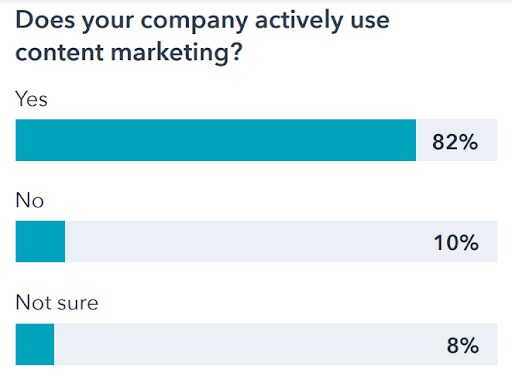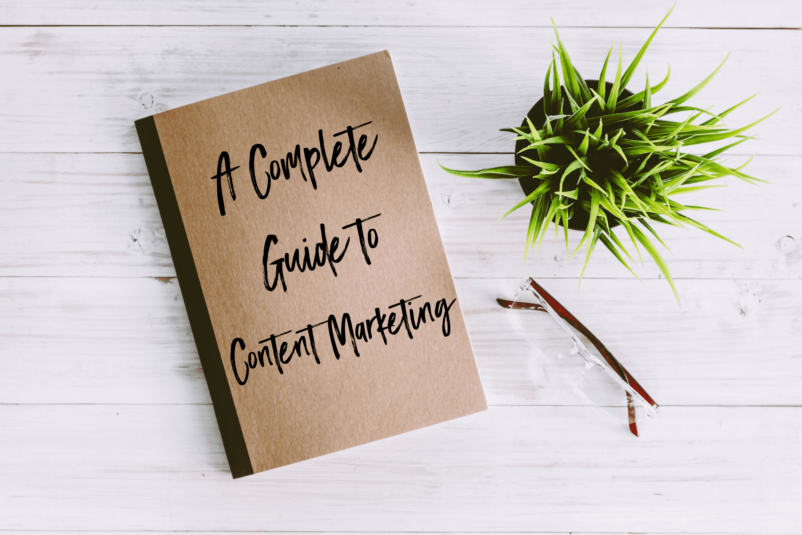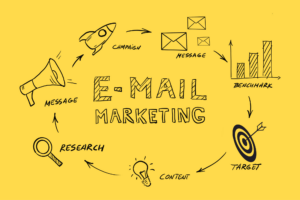As a small business, deciding how to spend your marketing dollars so you get the biggest bang for the buck can be difficult. So today, we want to share with you our complete guide to content marketing so you can see why every small business should be investing in content marketing to build their brand and fill their sales funnel.
 According to HubSpot’s State of Marketing Report, 82% of marketers actively use content marketing in 2021, and 28% plan to invest in content marketing campaigns.
According to HubSpot’s State of Marketing Report, 82% of marketers actively use content marketing in 2021, and 28% plan to invest in content marketing campaigns.
But what exactly is content marketing, and how can it help your small business? More importantly, should you invest in a content marketing strategy and campaign like many other small businesses?
This guide will share exactly what content marketing is, its benefits to small businesses, and tips for growing your business using content marketing.
Table of Contents
- Definition of Content Marketing
- Types of Content Marketing Format
- Examples of Content Marketing
- Why Your Small Business Should You Invest in Content Marketing
- How to Create an Effective Content Marketing Strategy
- 5 Tips to Achieve Content Marketing Success
Definition of Content Marketing
If you look up the definition of content marketing, here is what you’ll find:
con·tent mar·ket·ing
noun – a type of marketing that involves the creation and sharing of online material (such as videos, blogs, and social media posts) that does not explicitly promote a brand but is intended to stimulate interest in its products or services.
Simply put, content marketing is a strategic marketing approach focused on creating, distributing, and promoting valuable, relevant, and consistent content to attract and retain a clearly-defined audience — and, ultimately, to drive profitable customer action.

Types of Content Marketing Formats
Many types of content marketing formats are used in effective content marketing strategies. Some of the most common formats include:
1. Blog Content
Blog content is one of the most common types of content marketing. Blogging is a powerful tool for marketers looking to grow their brand presence, generate website traffic, educate buyers, and engage their existing customers. How do we know it’s so powerful? Here are two stats that prove the point:
- Companies that blog produce an average of 67% more leads monthly than companies that don’t blog. (DemandMetric)
- Marketers who prioritized blogging received 13X more ROI than companies that did not in 2019. (HubSpot)
2. Social Media Content
Social media content plays a pivotal role in attracting new customers, engaging with your target audience, delighting them, and generating a positive customer experience.
In fact, in a recent Hubspot report, social media is considered the #1 choice for marketers. 8 in 10 companies are already investing in social media marketing in 2021, while 39% plan to invest in 2021
3. Podcast Content

Podcasts are audio content that is published regularly in the form of episodes. When done right, podcast content marketing can add a whole new dimension to your branding and content marketing strategy.
The number of podcast listeners will increase significantly this year as the demand for audio-on-demand grows. By 2021, the number of monthly podcast listeners in the United States will increase by 10.1% YoY to 117.8 million.
We see podcasting building a more solid reputation as an effective content marketing technique with each passing year. We see more and more small businesses invest in podcasting because of its power to your business brand. In fact, in 2020, the number of podcasts doubled, with over 2.4 million podcasts being published.
4. Email Content
One of the most effective ways to generate sales and ROI for businesses is through email content. Email marketing delivers an average of $36 for every $1 spent in most businesses.
Creating personalized email content for your segmented audience can drive revenue, nurture leads, and build trust.
5. Video Content
According to a Wyzowl survey, 69% of consumers prefer to learn about branded products and services through video. In addition, video marketing helps increase conversions, improve ROI, and build relationships with viewers.
The great thing about video content is that it can be shared across many platforms, including social media, blogs, landing pages, websites, and emails.
Examples of Content Marketing
Need some kick-ass content marketing ideas to help build your content marketing strategy?
To get you inspired, let’s look at some great content marketing examples for each content marketing form.
1. Social Media Content Marketing Example

There is no lack of examples of social media content marketing. Facebook, Instagram, YouTube, Twitter, TikTok, and Pinterest are flooded with some of the best social media marketing campaigns.
One of our favorites is how Semrush uses Twitter to sell its software solution. With their targeted Twitter posts, they are able to build a community of customers by targeting audience members, industry leaders, and professionals.
Semrush not only shares product information, related tips, and knowledge on Twitter, but they regularly organize Semrush chats to engage with their audience. In addition, their social media team interacts with users to make it more fun and engaging.
2. Blog Content Marketing Example
VirTasktic is a boutique content marketing agency. As part of our efforts to grow our audience and reach out to more new potential customers, we regularly create and publish informative and interesting blog content.
While we don’t like to toot our own horn, the fact is that we’ve seen blogging work. Our blog serves as a tool to educate small business owners. It also allows us to reach larger audiences by building relationships with new people and industry leaders like Larry Kim, the founder of WordStream and MobileMonkey.
Additionally, we see an uptick in organic traffic, increased sales and revenue, and online brand presence for all of our clients who employ blogging as part of their content marketing strategy.
3. Podcast Content Marketing Example

There are thousands of amazing podcasts out there that you can listen to, and many of them can be used as an example for great podcast content marketing.
One of our favorites is HBR IdeaCast, a weekly podcast series organized by Harvard Business Review (HBR). Listeners can subscribe to receive notifications about new podcasts to learn about the industry insights and best practices. HBR connects with its target audience through this podcast series, improves brand awareness, and establishes its authority.
Why Your Small Business Should Invest in Content Marketing
An effective content marketing strategy allows you to target buyers at different stages of the sales funnel and create content that will guide them along the purchase journey.
But why content marketing? Here are three reasons:
- Content Marketing attracts 75% more qualified leads.
- Content Marketing costs 62% less than traditional marketing.
- Content Marketing makes 70% of consumers feel closer to a brand.
The effects of an effective content marketing strategy don’t end at the sale. You can use content marketing to create a positive post-sales experience that helps you retain your existing buyers and turn them into lifelong brand advocates.
Benefits of Content Marketing:
From driving online traffic to increasing sales, there are endless benefits of content marketing.
Here are a few key benefits your business can experience by investing in content marketing:
- Improve SEO and site rankings, which leads to more organic website traffic
- Generate brand awareness
- Increase ROI of marketing efforts
- Improve brand loyalty
- Increase user engagement
- Create a positive customer experience
- Increase your authority in your industry
- Generate a constant flow of prospects to your sales funnels
When a strategic content marketing campaign is employed in a small business, it has an overall positive effect on every aspect of the business. Creating valuable content helps increase your authority and thought-leadership. Consistent posting to social media helps to drive more traffic to your website. Effective email marketing nurtures prospects and provides lasting value to existing customers.
Content marketing is an overall win-win.
How to Create an Effective Content Marketing Strategy
When developing your content marketing strategy, it’s easy to get lost and confused. There are many factors that you need to consider.
Let’s look at the steps you can follow to create a content marketing strategy for your small business.
Step 1: Set Goals
Every successful marketer knows the importance of setting goals. And by goals we mean, SMART goals.
SMART stands for Specific, Measurable, Achievable, Relevant, and Time-Bound.
When developing SMART goals, you need to go through each of these five components to create a measurable goal that specifies:
- what needs to be done
- when it needs to be done
- how it will be done
This approach eliminates guesswork and identifies missing elements. It also makes it easy to track progress and outcomes.
While goals are specific to your brand, some of the common SMART goals businesses set are:
- Increasing brand awareness
- Boosting sales and conversions
- Driving brand loyalty
- Increasing customer engagement
- Building relationships and trust between prospects and customers
Step 2: Choose Your Marketing Channels
With content marketing, there are several marketing channels you can leverage. But being on all channels is not necessarily the best strategy.
When starting with content marketing, you don’t overwhelm yourself with too much pressure. Consistency is the key to success, and if you put too much on your plate, you’ll soon start dropping the ball, which will lead to failure.
First, you’ll want to understand who your ideal target market is and where they consume content. For example, if you are a fashion and lifestyle brand, TikTok and Instagram are two great platforms, to begin with. You can also leverage blogging to share educational content.
Once you know the type of content your audience wants and what platforms they are using, ease into a few channels that are manageable for you. Perhaps that includes writing a few blogs per month and promoting them on a couple of social media channels a few times each week.
Starting slow allows you to review your data, an important part of a content marketing strategy. Once you start publishing, you will quickly see what kind of content your audience reacts to and engages with. It will also allow you to see what social media channels bring you more traffic and engagement. All of this data can be used to fine-tune your strategy so you can deliver more of what your audience wants on the platforms they are using most!
Once your team expands, you can increase content production and include more channels.
Step 3: Decide on the Content
Once you know what channels you’ll be using, you need to decide what type of content you need to create.
If you plan on blogging or podcasting, this is where SEO will come into play. First, you’ll want to understand what keywords you want to rank for and find content ideas around those. Next, run a competitive analysis and find the types of content your competitors are creating and are more likely to get clicks and visits.
Tools like Neil Patel’s Ubersuggest can help you do the research needed to develop content ideas that will help boost your SEO rankings by providing content that your audience will be looking for.
Step 4: Create Valuable Content: Quality Trumps Quantity
Because more and more businesses are turning to content marketing because of its effectiveness, there is an endless sea of content to consume online. As a result, readers have more choices. But they also have less attention span.
No matter what, your goal when creating content is for the reader to walk away learning something that they didn’t already know or a skill that they can go and employ immediately to solve a problem. That’s the type of content that performs best!
Step 5: Include Social Listening
Social listening actively monitors conversations across social networks about your brand, products, competitors, or other industry-related, relevant keywords. By employing social listening in your content marketing strategy, you will better understand how audiences perceive your brand. You’ll also be alerted to industry trends, what your competitors might be doing, and more.
Social listening provides an additional stream of data to help you make important decisions about the type of content to create and the platforms you should be using.
In this article, Hubspot shares 14 social media listening tools you can explore for your business.
Step 6: Data: Monitor, Evaluate and Scale
It isn’t easy to improve what you don’t measure. That’s why data is so important.
As a part of your content marketing strategy, you’ll want to set up methods for tracking key parameters and KPIs to evaluate the overall success of your content marketing initiatives.

Some of the key metrics you’ll want to consider tracking include:
- Website Traffic (organic and referral)
- Time on Page
- Bounce Rate
- Backlinks
- Social Shares
- Post Engagement
- Click-Through-Rate
You can use Google Analytics, Google Search Console, and various free and paid platform-specific analytics tools to track your content performance and measure success.
5 Tips to Achieve Content Marketing Success
1. Partner With an Agency
Accept it. Creating content daily for blogs, social media, podcasts, etc., can be overwhelming. Ignoring this can lead to stress and poor outcomes for your content marketing efforts.
Partner with a content marketing agency and outsource tasks that take more time and creativity. This will free up time to concentrate on the areas of business that are within your strengths and engage with your clients without compromising on content production.
2. Maintain a Content Calendar and Plan Content in Advance
By creating a content calendar, you’ll find that creating new content becomes much easier. Additionally, it allows you to create more valuable content because you’ve been able to research topics.
Download our Content Planning Calendar to help you get started today.
3. Publish Content Consistently
Consistency is key to achieving success with content marketing. Create a schedule you can follow and publish the various forms of content you have planned accordingly.
Consistency in publishing content improves online and social media visibility. It also increases engagement and creates a buzz around your brand. Additionally, consistency will lead to more people following you and subscribing to your content.
4. Automate Where You Can
Automation can be your best friend in content marketing.
Finished writing your next blog? Head over to WordPress or any other CMS you use and schedule it to publish.
Done creating social media content for the month? Great! Now upload them to free or paid social media management tools and automate publishing.
With content automation, you can stay ahead of your publishing schedule and save an amazing amount of time and money.
5. Discover High-Potential Social Channels for Your Brand
Not all social media channels are going to provide you with similar results. As we discussed earlier in this guide, you need to research the best social channels for your business and brand.
For example, B2B businesses often see greater results on LinkedIn than on Instagram. On the other hand, B2C businesses often find greater results on Facebook, Instagram, and TikTok.
Content marketing is the best way for small businesses to drive more traffic to their website to reach more prospects and increase conversion rates. But it has to be done right, and it has to be strategic.

Take your time to think about all of the elements we outlined for your content marketing strategy. Then, be clear and honest about how much time you have to commit and If you have high enough knowledge to perform the various pieces involved. If you don’t, you will waste time and money – something we see every day with so many small businesses.
If you need some help getting started, get in touch with the VirTasktic Team for expert-level consulting and content marketing services.










Amazing! You have covered some really good points in your article! Love it!
The one thing that I liked the most was your focus on being consistent and maintaining a posting calendar and being persistent with it.
Along with persistence, it’s important that the content is valuable and SEO optimized.
Thanks, it’s a good read.